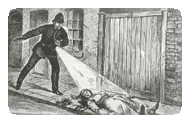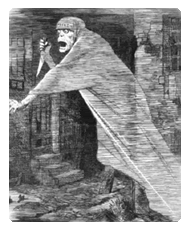Monday, October 17, 2005
The Final Solution by Walter Harmidarow-A Review
Queen Victoria, cobblestones, hansom cabs, fog, gaslit lamps, the cry of newsboys--all of these are familiar elements to aficionados of the Victorian Era.
The author of The Final Solution , Walter Harmidarow uses these elements and the more obscure items that are nonetheless well-known to the Victorianist--Bow Street, New Scotland Yard, Fenians, the Bradshaw.
Harmidarow also invokes that (probably) most famous of Victorian creations, Sherlock Holmes. Fans will recognize Baker Street, Holmes, Watson, Lestrade ("ratlike features"), Moriarty, Mycroft ("corpulent gentleman"), the Baker Street Irregulars, and Mrs. Hudson. What comes across most in Harmidarow's handling of the Conan Doyle creation is Harmidarow's evident joy and expertise in writing about these characters.
Harmidarow takes this mix and Conan Doyle's most famous character to write a pastiche worthy of the master.
Harmidarow deftly avoids the trap of merely stenciling a new "crime" over an existing account of Holmes; meaning, Harmidarow does not merely take a case that sounds like a Holmes case and predictably follow it through to the end. Rather, the author puts Holmes in the most dire of circumstances, attacking Holmes personally and professionally, as well as threatening Holmes's future reputation forever. Aside from the (unfortunate) title, there are few allusions to past canonical cases. This is a welcome omission, as too many authors pick up the Holmes mantle merely to parade their extensive knowledge of the character. Harmidarow goes further. However, there is a reason for the title, as devout fans will recognize.
One of the ways that Harmidarow dares to veer from the comfort of parroting rather than pastiche occurs in his treatment of Dr. Watson. Indeed, Watson's character does not fare well in most of Conan Doyle's stories; but this is more a reflection of the movies that are ingrained on our consciousness rather than strictly from the stories. Still, Watson fails to strike one as a dynamic character. Rather, he comes across as the quintessential foppish British man, dull and incredulous at any hint of aberrant behavior. Harmidarow allows Watson to remain as Conan Doyle has painted him, but does give the character some much-needed fleshing out. Watson (through Harmidarow) writes that
Contrary to the belief of my readers, I actually have
an excellent memory. Any 'discrepancies' that appear in my
narratives were solely used to mask facts and identities.
Yet later, Watson seems to revert to the stodgy and almost dim-witted foil when he accompanies Irishmen to Scotland Yard, remembers the Fenian bombing of the old Scotland Yard and then is surprised when they set off an explosion to allow Sherlock's escape. Even though they are subsequently exposed by Holmes as Italian rather than Irish, the jarring denseness of Watson remains.
Still, Harmidarow does give Watson not only a sense of humor but a sense of righteousness borne out of a tragic event, not just a simple-minded adherence to British idealism and sense of right and wrong. In its dealing with Watson, this story mostly resembles Conan Doyle's masterpiece The Hound of the Baskervilles. Watson is the primary investigator in The Final Solution while Holmes is "indisposed," as in Hound.
Holmes himself fares very well in Harmidarow's handling of the character. At times, Holmes even takes notice of Watson's honor, courage and friendship in ways that are lacking in the original canon. However, Harmidarow does this without diminishing Holmes's almost cold and calculating personality. Readers should not be concerned that Sherlock Holmes has mellowed. There are plenty of opportunities in the story for Holmes to make the difficult and almost unfeeling decision, which is part of the appeal of the detective. Also, Holmes has cause to revert to "criminal" behavior, giving Harmidarow the chance to repeat Conan Doyle's line that Holmes "would have made a first-rate criminal." This "other" side of Holmes is another facet of Holmes's character that has kept readers enjoying him and critics wringing their hands about what this means about Holmes, justice, the Victorian Era, etc. Harmidarow's story does nothing to diminish this fascinating aspect of Holmes's character.
Holmes, uncharacteristically, proves to be fallible in Harmidarow's novel. Holmes should have twigged to the fact that Lestrade may have been watching him when Holmes engaged in a bit of "breaking and entering," causing one of the book's many twists. There are other instances of Holmes's acuity failing him. Strangely, this does nothing to Holmes but to make him more human, as in his dealings with Watson.
Walter Harmidarow, an acknowledged expert on Sherlock Holmes, has created a story that, while true to the base elements of the Holmes canon, extends the characters and their adventures rather than merely taking them "out for a leisurely spin." Every character is fair game for re-analysis and Harmidarow wastes no time in diving in and gleefully taking the characters to both new heights and depths.
The author of The Final Solution , Walter Harmidarow uses these elements and the more obscure items that are nonetheless well-known to the Victorianist--Bow Street, New Scotland Yard, Fenians, the Bradshaw.
Harmidarow also invokes that (probably) most famous of Victorian creations, Sherlock Holmes. Fans will recognize Baker Street, Holmes, Watson, Lestrade ("ratlike features"), Moriarty, Mycroft ("corpulent gentleman"), the Baker Street Irregulars, and Mrs. Hudson. What comes across most in Harmidarow's handling of the Conan Doyle creation is Harmidarow's evident joy and expertise in writing about these characters.
Harmidarow takes this mix and Conan Doyle's most famous character to write a pastiche worthy of the master.
Harmidarow deftly avoids the trap of merely stenciling a new "crime" over an existing account of Holmes; meaning, Harmidarow does not merely take a case that sounds like a Holmes case and predictably follow it through to the end. Rather, the author puts Holmes in the most dire of circumstances, attacking Holmes personally and professionally, as well as threatening Holmes's future reputation forever. Aside from the (unfortunate) title, there are few allusions to past canonical cases. This is a welcome omission, as too many authors pick up the Holmes mantle merely to parade their extensive knowledge of the character. Harmidarow goes further. However, there is a reason for the title, as devout fans will recognize.
One of the ways that Harmidarow dares to veer from the comfort of parroting rather than pastiche occurs in his treatment of Dr. Watson. Indeed, Watson's character does not fare well in most of Conan Doyle's stories; but this is more a reflection of the movies that are ingrained on our consciousness rather than strictly from the stories. Still, Watson fails to strike one as a dynamic character. Rather, he comes across as the quintessential foppish British man, dull and incredulous at any hint of aberrant behavior. Harmidarow allows Watson to remain as Conan Doyle has painted him, but does give the character some much-needed fleshing out. Watson (through Harmidarow) writes that
Contrary to the belief of my readers, I actually have
an excellent memory. Any 'discrepancies' that appear in my
narratives were solely used to mask facts and identities.
Yet later, Watson seems to revert to the stodgy and almost dim-witted foil when he accompanies Irishmen to Scotland Yard, remembers the Fenian bombing of the old Scotland Yard and then is surprised when they set off an explosion to allow Sherlock's escape. Even though they are subsequently exposed by Holmes as Italian rather than Irish, the jarring denseness of Watson remains.
Still, Harmidarow does give Watson not only a sense of humor but a sense of righteousness borne out of a tragic event, not just a simple-minded adherence to British idealism and sense of right and wrong. In its dealing with Watson, this story mostly resembles Conan Doyle's masterpiece The Hound of the Baskervilles. Watson is the primary investigator in The Final Solution while Holmes is "indisposed," as in Hound.
Holmes himself fares very well in Harmidarow's handling of the character. At times, Holmes even takes notice of Watson's honor, courage and friendship in ways that are lacking in the original canon. However, Harmidarow does this without diminishing Holmes's almost cold and calculating personality. Readers should not be concerned that Sherlock Holmes has mellowed. There are plenty of opportunities in the story for Holmes to make the difficult and almost unfeeling decision, which is part of the appeal of the detective. Also, Holmes has cause to revert to "criminal" behavior, giving Harmidarow the chance to repeat Conan Doyle's line that Holmes "would have made a first-rate criminal." This "other" side of Holmes is another facet of Holmes's character that has kept readers enjoying him and critics wringing their hands about what this means about Holmes, justice, the Victorian Era, etc. Harmidarow's story does nothing to diminish this fascinating aspect of Holmes's character.
Holmes, uncharacteristically, proves to be fallible in Harmidarow's novel. Holmes should have twigged to the fact that Lestrade may have been watching him when Holmes engaged in a bit of "breaking and entering," causing one of the book's many twists. There are other instances of Holmes's acuity failing him. Strangely, this does nothing to Holmes but to make him more human, as in his dealings with Watson.
Walter Harmidarow, an acknowledged expert on Sherlock Holmes, has created a story that, while true to the base elements of the Holmes canon, extends the characters and their adventures rather than merely taking them "out for a leisurely spin." Every character is fair game for re-analysis and Harmidarow wastes no time in diving in and gleefully taking the characters to both new heights and depths.
Labels: Jack the Ripper, Jack the Ripper and Me
















Post a Comment
<< Home